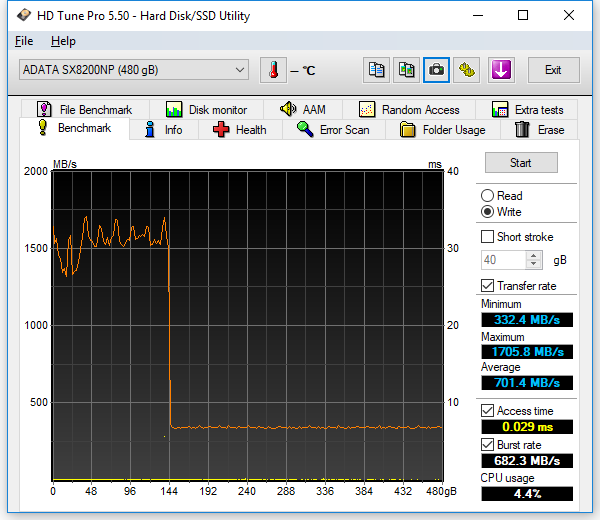HDTUNE
HD Tune is a Hard Disk Utility with many functions from error checking, health testing (S.M.A.R.T.), and of course benchmarking. To build upon our real world write test we also looked to see where the write speeds leveled off to by using HD Tune Pro. If SLC caching is being utilized, this test will typically show it.
Finally, taking a look at how it performs under HDTune’s full write test, we can see that once the SLC cache fills that the write performance will degrade to about 330MB/s. While looking at that number alone can be disappointing, we must take into consideration the graph as a whole above. It took over 140GB of data written before it dropped in performance. That really isn’t that bad at all.
REPORT ANALYSIS AND FINAL THOUGHTS
Looking back at the results we always have to ask, does the SSD meet its specs by the manufacturer? It is one thing to market high-end performance and it is another thing to deliver it. To ADATA’s relief and just as much to our own, the XPG SX8200 lives up to most of their claims. 3.2GB/s read and 1.7GB/s write was easily attained under our test regimen. The 4K random performance reached nearly 320/253K IOPS read and write in AS SSD, write performance just shy of the 280K IOPS write ratings. In PCMark 8 it delivered the respectable performance of just under 500MB/s and landed right below the new Samsung 970 EVO 2TB and just above the Intel 760P on our hierarchy chart.
Next up, during our power consumption testing, the ADDATA XPG SX8200’s results were fairly efficient and idle consumption results were some of the lowest yet, however, there is still room for improvement. SATA devices have been idling at under 0.1W for years now and the 950 Pro and 960 EVO idle around that too. It’s time for other manufacturers to step their game up when it comes to idle power draw. It matters.
Finally, based on our real-world file folder drop and some help from HDTune, we can see that the XPG SX8200 delivers very good consumer write performance as well as decent enough performance for more advanced media editors. It took nearly 150GB of data to fill the SLC cache and hinder write performance to 300MB/s. Mind you this was nearly back to back after running our PCMark 8 extended test. In real-world workloads, this should be enough for most and if performance does degrade, it should bounce right back soon after some idle time.
The ADATA XPG SX8200 is a good performing NVMe SSD all around. While it isn’t a benchmark king, it delivers solid performance at a great price. At around $0.41-0.42 cents per GB it is hard to complain about what you are getting. The XPG SX8200 comes with an SSD Toolbox to monitor the SSD and Acronis True Image to clone your old OS drive to your new one if it so pleases you to do so. In addition to that, it has some fairly high endurance numbers and is backed by a 5-year warranty, just like some of the other premium SSDs in the market. The optional head spreader is great because it allows the end-user to apply it in whichever way matches their M.2 slot orientation. And, based on our testing, it is truly a great buy for those with high demand applications including multimedia editing, gaming, rendering, and possibly overclocking, just as ADATA states.
Taking all this into consideration, the ADATA XPG SX8200 turns out to be one of the best value SSDs we have tested and has earned itself our Top Value Award.
 The SSD Review The Worlds Dedicated SSD Education and Review Resource |
The SSD Review The Worlds Dedicated SSD Education and Review Resource | 

